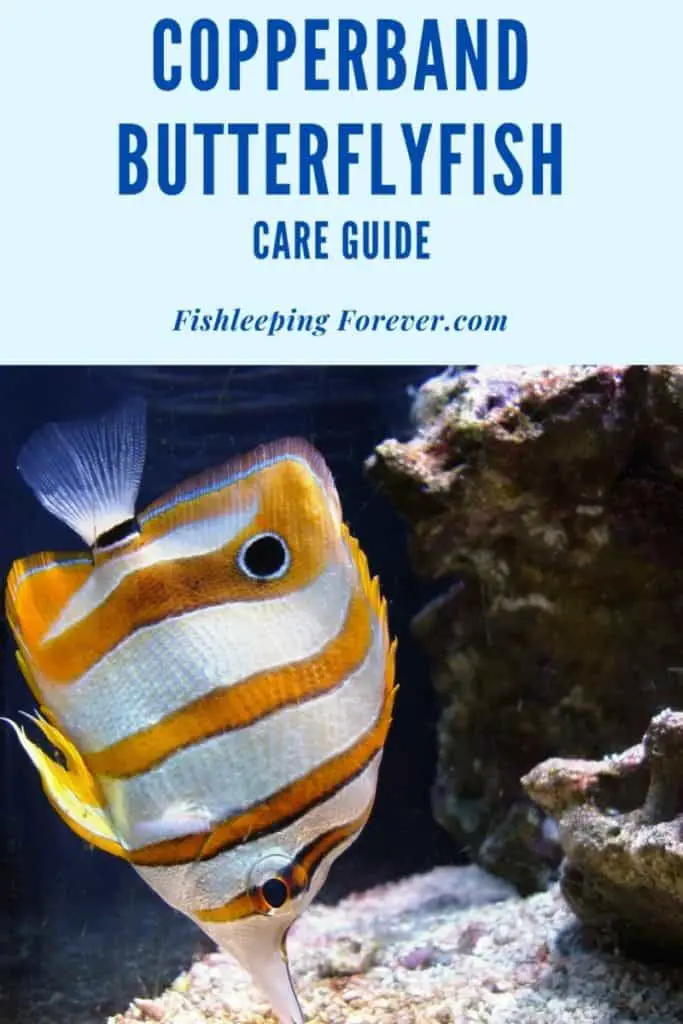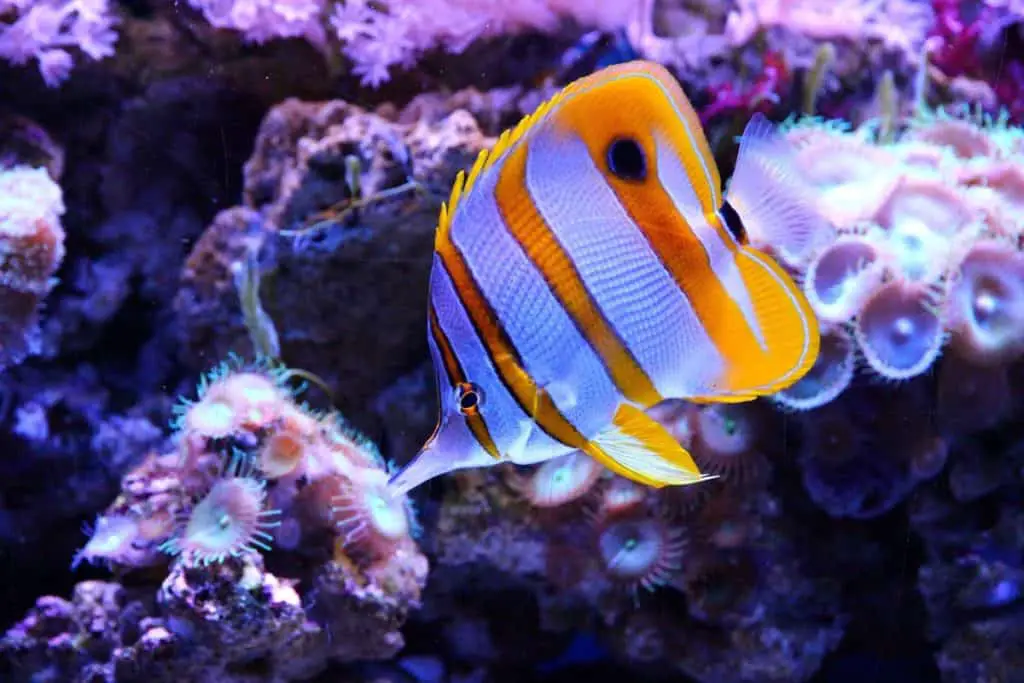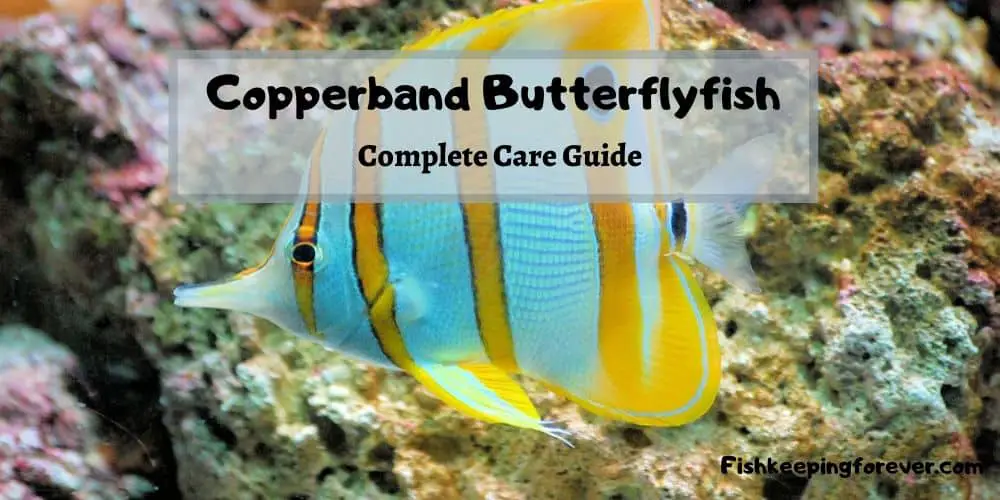Creating a tank community is all about the balance of size, form, character, and disposition of the species you choose to select. An excellent pick, especially for the experienced aquarist, is the inimitable Copperband Butterflyfish. This distinctive tropical reef-dweller is carnivorous and may be partial to your shrimp, but is generally considered reef-safe and a welcome member to well-established peaceful communities.
Its characteristic golden-orange bands and faux-eye spot on its tail, this fish is sought after for its vivid colors which will enhance any marine or reef tank. However, Copperband Butterflyfish needs the nuanced care of expert hands and strict maintenance of the parameters necessary for them to thrive.
In this complete guide, we provide a handy overview of the key aspects of making this brightly colored fish a successful addition to your aquarium.

Table of Contents
The Reef Origins of the Copperband Butterflyfish
The CopperBand Butterflyfish, known in Latin as Chelmon Rostratus, is a ray-finned bony fish. It is a member of the Chelmon family, which are distinguished by their long beaks and distinctive patterns.
The other Chelmon species are all tropical but differ from C. Rostratus in coloring, pattern and dorsal fins.

As mentioned above, the Copperband Butterflyfish is a reef dweller and makes its habitat in the tropical ocean reefs of the Indian and Pacific Oceans. There it roams coral or rocky reefs alone or perhaps paired with a mate.
It is carnivorous and has territorial tendencies, though, for the purposes of aquarium keeping, it is considered reef safe.
You can find out more about the reef safety of this fish in the article
“Is the Copperband Butterflyfish reef safe?”
Here are some alternative names the CopperBand Butterflyfish is known by:
- Copperband
- Copperbanded Butterflyfish
- Longnose Butterflyfish
- Long-beaked Coralfish
- Banded Longsnout Butterflyfish
- Banded Longsnout Butterflyfish
- Pipit
- Beaked Butterflyfish
- Beaked Coral Fish
- Orange Stripe Butterfly
Species Profile
| Scientific Name | Chelmon rostratus |
|---|---|
| Common Names | Beaked Butterflyfish, Beaked Coralfish, or Orange Stripe Butterfly |
| Care Level | Difficult due to diet |
| Temperament | Peaceful |
| Size | 7-8" Maximum |
| Color | Orange, White,black and Yellow |
| Diet | Carnivore |
| Reef Safe | Yes, with some cautions |
| Water Conditions | 72-79° F, dKH 8-11, pH 8.1-8.5, sg 1.020-1.026 |
| Tank Size | 120 Gallons |
| Price | $40-80 |
CopperBand Butterflyfish physical characteristics and dimensions
Let’s take a look at the Copperband Butterflyfish colors, shape and size.
Copperband Shape
The Orange Stripe Butterfly has a compressed body shape with an elongated beak which is almost as long as its body. This disc-like fish is known to wedge itself between narrow rocky gaps to hide out from bigger or predatory reef dwellers.
The lateral sides of the fish are rounded, with a similar shape to angelfish, and it has a number of stiff dorsal spines that it uses in defense and can cause injury if the fish is mishandled.
Copperband Butterflyfish Size
Copperband Butterflyfish can grow up to a size of 20cm (8-inches) in their ocean habitat, but typically achieve only half this size when kept in an aquarium.
Coloring of the Copperband Butterfly Fish
This butterflyfish is known for its vivid gold-orange bands, about four in total, that stripe its body on both sides. The characteristic bands may have a darker margin.
The background color of this fish is a pearlescent white. At the base of its tail, a long dark band runs perpendicularly. Another notable feature on this butterflyfish is its dark-colored false eyespot, which is, in fact, darker than its actual eye and located on its dorsal fin.
It is thought to have this to confuse and elude predators.
Do Copperbands change color?
As the Copperbanded Butterflyfish matures, its coloration can vary in tone and intensity. Color changes may also be indicative of stress or disease. Juveniles have the same appearance as mature fish. Males and females also have a similar size and shape.
Other features
A long snout is a shared feature with other butterflyfish and used to forage in crevices in the coral reefs for its diet of worms and coral polyps.
Copperbanded Butterflyfish lifespan
As with all but the hardiest aquarium fish, the conditions and level of care of the Copperband will largely determine its longevity. Because of this, many of these butterflyfish are short-lived at the hands of inexperienced or neglectful aquarists.
With proper attention paid to diet, disease and water conditions, the Copperbanded Butterflyfish can achieve a life span in excess of 10 years.
Experienced aquarists who are familiar with the handling of this fish report achieving several years in an aquarium, though it is not often clear how old the fish is when it was first obtained.
When purchasing a Copperbanded Butterflyfish, fish that have disease present or poor appetite and activity tend to fare worse when transferred to your tank. Treating disease is a major stressor to these fish and often kills them faster than not eating.
What is a Copperband Butterflyfish’s behavior like?
Whether out on the reef or in your tank, this butterflyfish has the potential to become a little bossy.
Copperbanded Butterflyfish are known to be territorial, and willing to tangle with Tangs, Wrasses or their own species if not carefully introduced to a tank.
In their natural environment, these butterflyfish have linked spacing and feeding behaviors and maintain their territories in monogamous pairs. If not mated, these fish lead solitary lives and so are able to be introduced singly to an established aquarium.
Aside from foraging and grazing, Copperbanded Butterflyfish also may hide on rock crevices, which is a behavior used to escape predation. Illness, stress, and cold may diminish feeding and cause listlessness or an increase in aggression so any behavioral changes should prompt a review of tank conditions with quarantining if needed.

Diet of the Copperbanded Butterflyfish
These butterflyfish are predominantly carnivorous but can be trained to eat algal-based feeds.
In their natural habitat Copperbanded Butterflyfish will dine on the diverse range of sea organisms available including:
- Corals
- Sponges
- Shrimp
- Plankton
- Worms
- Sea anemones
- Algae
- Seaweed
Experienced aquarists know that they will need to work to establish this fish on a variety of foods to broaden the options available for feeding in the tank. Maintaining the appetite of your fish will increase its size and ability to fend off disease.
Here are some suggestions of foods which can be added to the Copperbanded Butterflyfish’s diet:
- Brine shrimp
- Clams
- Mussels
- Blackworms
In addition to these live foods, frozen Mysis shrimp and worms can be offered, perhaps secreted in the crevices of a rock so that your Copperband can mimic its natural foraging behaviors.
Once the Copperbanded Butterflyfish is established on one food, introduce others until you have a range of feeding options to hand.
Both live and frozen foods may need to be treated with metronidazole to prevent transmission of disease to the fish.
Copperband Feeding Guide
| Food | How Often | How Much |
|---|---|---|
| Flake Food | 3 Times a day | Enough to consume in 90 Seconds |
| Pellets | 3 Times a week | 1-2 Mini Pellets Per Fish |
| Bloodworms - live | 2 Times a week | 1/4 Teaspoon of worms per fish |
| Bloodworm - Freeze Dried | 2 Times a week | Small Pinch |
| Algae Wafers / tablets | 2 Times a week | 1 Tablet or wafer per 10 fish |
| Brine Shrimp - Live | Once a week | 1-2 Brine shrimp per fish |
| Other supplement foods or Vegatables | 2 Times per week | Enough to consume in 90 Seconds |
Can you breed Copperband Butterflyfish?
The Copperband Butterflyfish is of low conservational concern and mature specimens are usually acquired for sale. In their natural environment, these oviparous fish form a mating pair and reproduce by laying eggs amidst the rocky crevices of the reef, which are subsequently fertilized by the male.
The tiny fry have special armor plating that protects them from predatory species while they grow.
Copperbanded Butterflyfish have not been successfully bred in captivity, but there have been accounts of the successful rearing of fry and juvenile fish.
You can check the ICUN LIST for more details about endangered fish species and ones that are in danger of becoming at risk.
Aquarium conditions for the Copperbanded Butterflyfish
The proper maintenance of your marine or reef aquarium will be critical for the survival of the Copperband. Variable water parameters can harm or even kill these fish, so a watchful eye on conditions is essential. As with most tropical fish, consistency is key.
Stressing these butterflyfish with poor conditions suppresses their appetite and activity levels and makes them susceptible to disease.
Vigilance, scrupulous cleaning, and readiness to quarantine will help you achieve a long life for your Copperbanded Butterflyfish, and aquarists that put the effort in will see good results with this fish.
Create a stimulating environment for your Copperband
The aquarium environment of the Copperbanded Butterflyfish should introduce variety and interest so your fish can thrive. Create a rocky aquascape with plenty of hiding and feeding places where your Copperbanded Butterflyfish can exhibit its natural behaviors.
These fish also need open water where they can swim freely which will place a demand on your tank size and capacity.
Copperband Butterflyfish can certainly be advantageous in a reef environment, especially as it has a predilection for Aiptasia anemone species and can help keep their numbers down.
On the other hand, your butterflyfish may just want to tuck into prized polychaete worms or shrimp that are helping to keep your tank clean.
If you are keeping large polyped stony corals it may be partial to those too, though nibbling can be curved by providing a plentiful supply of food.
What is the ideal tank size for Copperbanded Butterflyfish?
Copperbanded Butterflyfish are keen swimmers so you need to take account of this in your tank layout. As these fish can achieve sizes of up to 20cm, it is important to have a generous tank volume with as much length as possible.
At a minimum, a volume of 78 ones should be suitable for a single Copperband, with larger tank sizes required if a pair is kept.
Water changing regimen
Water for these fish should be clean and well-oxygenated, though massive changes can prove counterproductive. Aim to change 10% every two weeks or 20% of tank water per month.
Do Copperbands need water movement?
Though Copperbanded Butterflyfish can tolerate fast water movement they prefer slower moving water, which will aid in facilitating behaviors other than swimming, like hiding and foraging.
Light is not a significant requirement for this fish which has a diurnal pattern of behavior. Shaded areas should be created within the tank for hiding.
Water temperature for the Copperbanded Butterflyfish
These fish fare well in a warm, reef tank environment. Keep a close eye on temperature which should be maintained within the range of 23 to 27 degrees Celsius (73.4 to 80.6 degrees Fahrenheit), with little to no fluctuation.
Copperbanded Butterflyfish water chemistry
Water chemistry affects the wellbeing of the Copperbanded Butterflyfish and so should be kept within the appropriate limits.
- Copperbanded Butterflyfish has a pH range of 8.1 to 8.4.
- Specific gravity should be 1.020 – 1.025
- Ideal water hardness should range between 8 and 12 dKH.
Nitrogen levels are also a concern but should not preclude feeding this fish liberally.
Suitable tank mates for your Copperband Butterflyfish
Copperbanded Butterflyfish is reef safe, meaning it can dwell in a reef community without any predatory, territorial or aggressive behaviors disturbing the peace.
It may, however, have friction with its other Copperbands or related species. A pair may be carefully introduced, but as this fish is comfortable as a solitary dweller, they are probably managed best as the sole Butterflyfish in the tank.
Feeding this fish well with an assortment of live and frozen foods will mitigate any tendency to nip shrimp or other reef dwellers.
Here are some other reef safe marine species that are ideal tank mates for your Copperband:
- Gobies
- Dartfish
- Dottybacks
- Assessors
- Fairy Wrasses
- Dwarf angelfish
- Damselfish
- Pipefish
- Seahorses
- LPS and SPS corals
- Shrimps, crabs, and snails
Soft-bodied species, crustaceans, as well as bigger, more aggressive and more predatory fish species will require careful monitoring when placed with a Copperbanded Butterflyfish.
Diseases in Copperbanded Butterflyfish
Copperbanded Butterflyfish are susceptible to a number of common diseases and parasites which can stress these fish, diminish appetite and growth and eventually kill.
Many of these diseases can be transferred to your tank by the purchase of a fish that is infected at purchase. For this reason, it is prudent to quarantine a new Copperband, to assess and treat any disease present.
Here are the most common conditions encountered by owners of Copperbanded Butterflyfish:
- Marine Ich or white spot disease is an ectoparasitic infection by an organism called cryptocaryon irritans which produces characteristic white spots and lesions on affected fish. Infected fish often have poor appetite, lethargy or rub or scratch themselves against rocks or substrate. Copper treatments are typically used but may be poorly tolerated by an affected fish.
- Uronema marinum is another parasitic infection of marine fish that often proves fatal to Copperbanded Butterflyfish due to poor tolerance of the treatments. Affected fish suffer painful external and internal lesions. It requires prompt intervention with a formalin bath with transfer to a quarantine tank for follow up treatment.
- Coral Reef Fish Disease also known as Marine Velvet, produces a rust-colored, powdery coating on a Copperband’s body, along with irritability and a raised respiratory rate. Fish affected with this condition fare best when quarantined promptly and treated with copper sulfate.
- Lymphocystis is a viral infection that produces white growth and swellings on affected fish. It can remit but is contagious and so requires quarantining of the affected fish.
Conclusion: Copperband Butterflyfish Care Guide
A Copperbanded Butterflyfish, like many tropical fish, is a beautiful addition to your tank that requires hard work and will stretch your experience.
The key to success with this fish appears to lie in selecting a healthy fish that is active, eating and disease-free. A healthy Copperband, kept in optimal conditions, will enjoy good longevity.
Plentiful food options, hideouts, and space to exercise will keep your Copperbanded Butterflyfish a contented and your aquarium community peaceful.
- Comparing Aquarium Gravel To Sand – Which Is Best For Your Tank?
- Silver Arowana: Complete, Care, Breeding, Feeding Guide
- Rainbow Shark: Diet | Size | Breeding | Cost
- Tiger Barb Fish: Diet | Breeding | Size | Water Conditions
- Jack Dempsey: Diet | Size | Breeding | Lifespan | Sexing | Care Guide

I have been working in the tropical fish industry for over 30 years now and I’m still learning. Everyday is a school day in this hobby. In my spare time I play golf very badly!


